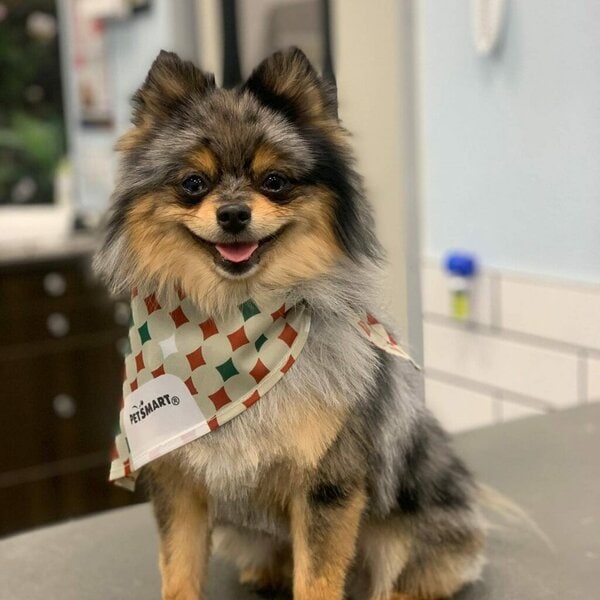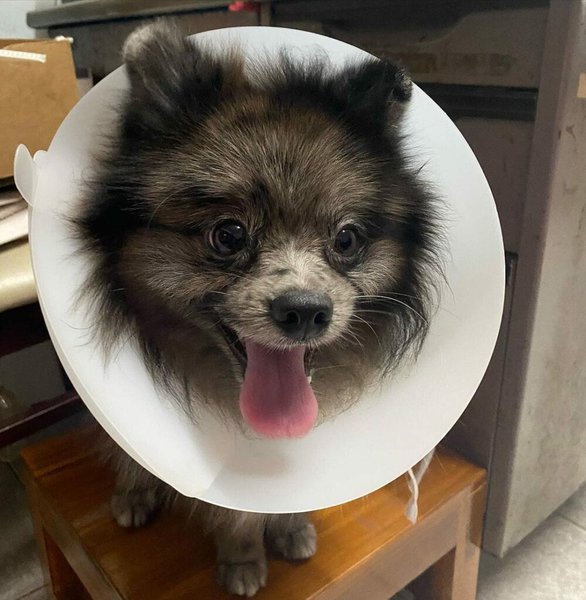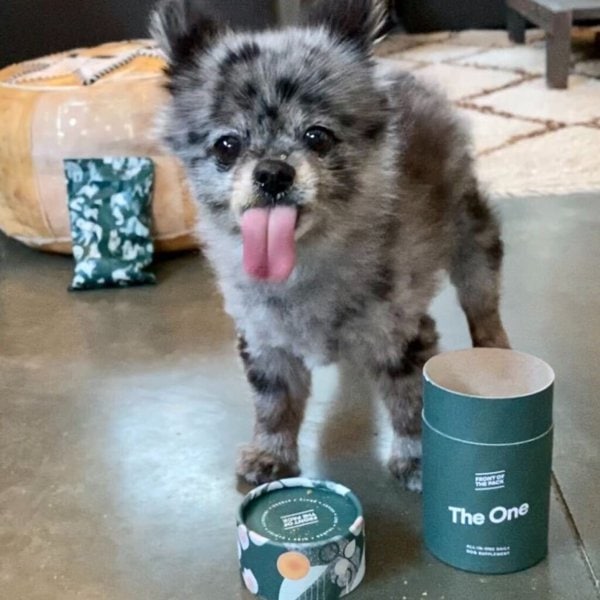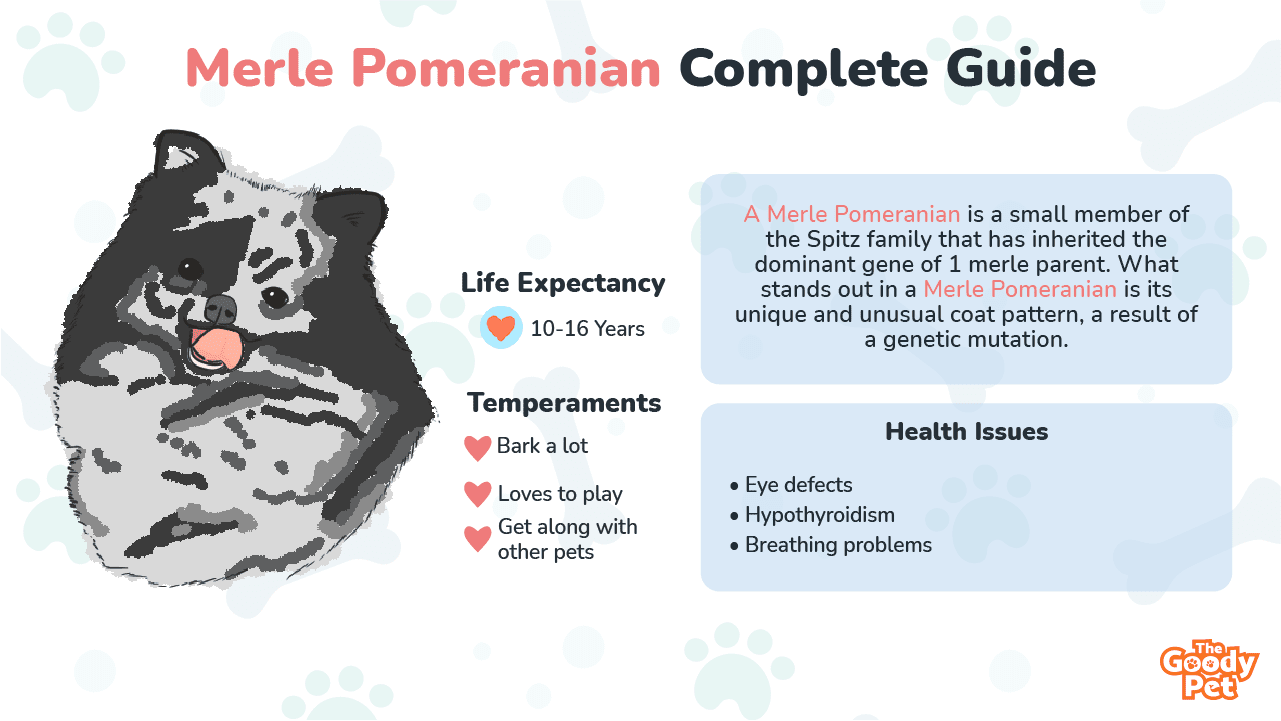Merle color (also referred to as dapple) is an inherited gene responsible for the speckled and kaleidoscope of colors in a dog’s coat. Merle is one of the most attractive coat patterns in a dog’s world.
The Merle Pomeranian is a fairly new coat color in the world of Pomeranian dog breed. It is so beautiful that the Merle Pomeranian is one of the most sought-after in the US. However, you wouldn’t see a Merle Pomeranian in some countries since kennel clubs like the FCI do not accept this color. Though recently, there have been cases where Merle Pomeranians have been allowed to join AKC dog competitions.
In the sections below, we’d share with you more information about a Merle dog breed. Do they have a long lifespan? Are they pleasant to live with? Is a Merle Pomeranian the same as a Brindle Pomeranian? But for now, we will talk lengthily about the rarity and genetic defects of a Merle Pomeranian.
What Is A Merle Pomeranian?
A Merle Pomeranian is a small member of the Spitz family that has inherited the dominant gene of 1 merle parent. What stands out in a Merle Pomeranian is its unique and unusual coat pattern, a result of a genetic mutation.
This means that a Merle is through and through Pomeranian, a resulting breed that happens only from a purely Pomeranian ancestry with one or both parents carrying the merle gene. In other words, a Merle Pomeranian is a purebred dog.
Physical Features
Merle Pomeranians have a unique coat pattern that is characterized by marbling or having dark patches against a lighter primary base color of brown, black, or white. The colors and the sizes of the patches are varied, too.
Some of the unique physical features of Merle Poms are the pink and black speckled paw pads and noses. Most of them have blue eyes. Though, sometimes, it is not uncommon to see a Merle Pomeranian with 1 blue and 1 brown eye.
Given all those variations, you cannot see Merle Pom with identical colors and specks.
How Rare Is A Merle Pomeranian?
You may not see a lot of them around but it doesn’t mean that the Merle Pomeranian is rare. Yes, there may be genetic difficulties but if you look through breeder’s websites, you’d find that most of them sell a Merle Pom.
We cannot say that the merle gene is defective, rather it is heterozygous, meaning, a Merle Pomeranian inherited 2 types of a particular gene from both parents. As opposed to homozygous genotype where the Pomeranian inherits identical forms of a particular gene.
The Merle gene is usually considered to be bad. This is because the breeding practice of two Merles results in ‘lethal whites’, a condition wherein the offspring puppies have no or very little color to their coats, plus they are highly prone to becoming blind, deaf or both.

Are Merle Pomeranians Healthy?
Most Merle Pomeranians live up to 10 to 16 years. Unfortunately, there are more health problems associated with Merle Pomeranians. These health problems worsen even more if 2 Merles are mated together.
Listed below are the common health issues of Merle Pomeranians.
Eye Defects
The Double Merle Pomeranian (2 Merles bred together) is more susceptible to deafness and eye defects. Some of these are lack of retinal pigment, microcornea, and microcoria.
Additionally, male double Merles are known to suffer from reduced sperm counts.
Hypothyroidism
An endocrine disorder that is caused by an underactive thyroid gland. If your Merle Pomeranian is afflicted with hyperthyroidism, it means that its body is not producing the right amount of thyroxine hormone which is responsible for metabolic processes.
Some of the symptoms are low energy, weight gain, and hair loss.
Breathing Problems
A Merle Pom can be afflicted with different types of breathing problems and one of those is a collapsed trachea. Some causes are genetic defects and tumors in the trachea. The common sign is a honking noise pretty much like the sound of a cat that is regurgitating a hairball.
Another kind of breathing problem among Merle Pomeranians is pharyngeal gag reflex or reverse sneezing. This happens when your Pom has sudden, rapid, and strong inhalation of air through the nose. This causes snorting and hacking/honking sounds, hence it’s called reverse sneezing.
Coat Loss
Also known as Alopecia X, the coat of a Merle Pomeranian will start growing normally but as the dog ages, you’d notice premature thinning of the coat at the back and bottom areas.

How To Take Care Of Merle Pomeranians?
Exercise Needs
A small dog brimming with energy, you need to provide your Merle Pom with 30 minutes of daily exercise like walking. When doing so, bear in mind that your Merle Pom has short legs, meaning, what may be a slow pace for you is a fast pace for your fur baby. This is why running with your Merle Pomeranian is not highly recommended.
You’ve got a yard? Playing fetch and tug-of-war are also good exercise options.
Diet
The ideal serving for your Merle Pom is ¼ to ½ cup of wet food, divided into 2 meals every day. We highly recommend you feed your fur baby with wet food because it is more palatable and has higher water content needed for hydration.
When choosing wet food, be mindful of the ingredients. Same as you, your Merle Pom is affected by what it eats. The healthiest choices are freshly cooked and human-grade wet dog food which is what your Merle Pom will get if it eats Pet Plate. Here are more of the reasons to choose Pet Plate:
- All meal plans are designed by a Vet nutritionist
- All-natural human ingredients like real meat, veggies, and fruits
- Personalized meal plan based on your Merle Pom’s age and activity level
Multivitamins
You can give your Merle Pomeranian chewable multivitamins to support healthy digestion and for skin and coat maintenance. Do choose the one that contains glucosamine and chondroitin for hips and joints.
Also, as an added care for your Merle Pomeranian, you should invest in dental water additives for its dental hygiene.
Can Merle Pomeranians Be Left Home Alone? Temperaments Of Merle Pomeranians
Merle Pomeranians get attached to their human families, thus, it is fairly common to see most of them having separation anxiety issues. But, once trained, the adult Merle Poms can be home alone for a max of 6 to 8 hours. In some cases when the Pomeranian separation anxiety is too much, they shouldn’t be left alone for more than 5 hours.
Temperaments
An extroverted dog that loves being around its human family, there’s never a dull moment with a Merle Pom. This little one loves to play a lot making it a perfect choice for dog lovers with kids. The Merle Poms also get along well with other pets, including cats.
Though they are one of the sweetest, we warn you that Merle Pomeranians can be chatty and yappy. As a result of their protective nature, they tend to bark at just about anything. You have to understand that they have in them the gene of a German Spitz, making the Merle Pomeranians good watchdogs.
Are they aggressive? They can be suspicious of unfamiliar faces. As a result, fear can turn into aggression. This behavior can be curbed through training and socialization.
Trainability
The Merle Pomeranians are smart dogs that can easily learn basic commands and tricks. The same holds true when it comes to potty training. You have to keep in mind that your Merle Pom will react well to consistent and reward-based training sessions; otherwise, their stubbornness may kick in.
We also recommend that you start to socialize your Merle Pom as early as 16 weeks to prevent fear and aggression.

Do Merle Pomeranians Shed? Grooming Tips For Merle Pomeranians
These cute and fluffy little ones are moderate shedders, thus, the Merle Pomeranians are not hypoallergenic. In short, they are unsuitable for allergy sufferers.
The male Merle Pomeranians shed their undercoats once a year while the females during their heat season and after giving birth.
How Often Should You Brush Merle Pomeranians?
All Pomeranians are double-coated, consisting of an undercoat and a longer topcoat. To keep your surroundings hair-free, daily brushing is required. This allows you to better manage its fur so it will not get matted and reduce shedding.
But, don’t just use an ordinary brush; instead, use the one that will really target the undercoat without causing damage to the beautiful Merle topcoat. And, I am talking about the Furminator Undercoat Tool.
Why choose the Furminator Undercoat Tool? First, it comes in 3 sizes, so there’s one that perfectly matches the size and weight of your fur baby. In the case of Merle Pom, the small size (for 25 lbs and below) will do an awesome job in significantly reducing loose undercoats.
Second, because of the ergonomic design, it’s comfortable and very safe to use. Third, it’s made with a skin guard that glides smoothly over the skin.
How Often Should You Shampoo Merle Pomeranians?
For as long as you are diligent in brushing the coat daily, you do not have to wash its coat frequently. Once in every 3 weeks is what we recommend. Use a mildly scented, soap-free shampoo that won’t cause dryness and itchiness like the Seamus Cherry Blossom Whitening Dog Shampoo.
Related Questions
How Much Is A Merle Pomeranian? A Merle Pomeranian is worth an average of $3,000. The Merles are more expensive because of the special care that goes with breeding. The other factors that affect pricing are gender and the breeder’s location. Add to that the time of the year wherein the demand is higher during the spring/summer months.
Is Merle The Same As Brindle? No, it’s because merle and brindle are different coat color patterns. In the case of merle, it’s more about having darker specks of irregular shapes against a background of a lighter color. On the one hand, brindle coat patterns are irregular tiger stripes rather than specks or spots against a lighter base color.
What Is The Most Rare Pomeranian Color? The Lavender or Lilac Pomeranian is the rarest Pomeranian color. The fur has a grayish hue with some light purple markings. The lavender-colored Pomeranian is achieved by breeding 2 dogs that have diluted genetics, for example, a beaver and a blue-colored Pomeranian. However, as of now, the Lavender Pomeranian is not yet an accepted color by AKC.





